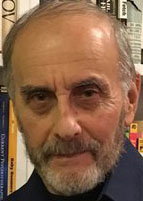The exhibit recognized the power of the universal language of art to transmit messages in a way that words cannot. Potent images remain embedded in our memory and return when triggered by life events. Art speaks to everyone -- regardless of age, religion, culture, social status, or education.
Historian Simon Schama,in his PBS series "The Power of Art," reminds us of the unique power of art to impact our thinking. He cites Pablo Picasso's huge mural Guernica, which depicts the horror and atrocities of the Spanish Civil War: "Guernica was art's cry of pain against modern savagery."
Powerful art images can forever mediate the way we see the world. While some images inspire, convey truth, and expose injustice, others can brainwash us with destructive distortions and false ideologies. Some artworks can cleverly present positive inspirations and at the same time subtly propagandize destructive ideologies.
That is the case, I discovered, with Renaissance images of Jesus, his family and followers. In one respect a vast trove of Renaissance artworks inspire devotion and intensify faith in Christianity. On another level, though,they falsify biblical history and reinforce the divide between Christians and Jews, which has had lethal consequences for Jews over many centuries. The falsifications were all the more compelling because they were made subtly, by omission. What has been omitted is Jesus' Jewish identity. You can walk through gallery after gallery in museums around the world, as I have, and you will rarely see any evidence that Jesus was a Jew or had any connection to Judaism or to the Middle East where he was born and where he preached. Indeed, he is typically pictured as Northern European in appearance, with fair skin, blond hair, and blue eyes. And you will likely find him and his family and followers in regal attire, in palatial Renaissance settings, surrounded by symbols of a religion -- Christianity -- that didn't exist during his lifetime.
This imagery negates the undisputed fact that the Jesus of the Gospels lived and died a practicing Jew. Although his life and teachings inspired a new religion, which became an organized Church more than three hundred years after the crucifixion, one would expect that his connection to Judaism would at least be hinted at in these artworks.
Jesus' dedication to Judaism was not portrayed in Renaissance artworks for several reasons related to the evolution of Christianity as it emerged and separated from Judaism. But that doesn't explain why modern art historians, critics, and curators maintain the deceptions and falsification of biblical history. These art professionals analyze the most minute details of paintings, even using advanced technologies, but ignore the most glaring feature: the falsification of biblical history that can be seen with the naked eye.
Art professionals casually dismiss the distortions as artistic license in the service of the Renaissance style of contemporizing images. Furthermore, some art experts have told me, "everyone knew that Jesus was Jewish -- it was in their bible in the Gospels." If Christians had read the bible that would have helped correct the distortions but still not justifying the artwork falsifications.
The unfortunate truth is that despite loving their bible few Christians read it for well over a thousand years. For one thing, the Church discouraged Christians from reading the bible on their own. For another, relatively few bibles existed. Through the Middle Ages and early Renaissance copies of the bible were individually crafted by skilled scribes. Each copy was beyond the means of commoners (equivalent to as much as $100,000 today). Moreover, the bible was written in Latin, a language that virtually no one in the general population could read or speak. Well over ninety percent of Europeans were illiterate. Even many of the clergy couldn't read the Latin bible. And translating the bible into native languages was strictly forbidden. As late as the sixteenth century William Tyndale was burned at the stake for his English translation--and not because it was a bad translation. As much as 60 percent or more of today's King James version is Tyndale's translation.
So how did commoners and others learn about Jesus and Christianity?
Their information came largely from three sources, all of which were heavily tainted with distortions and propaganda. From priests, monks, and nuns the population heard stories that focused on miracles, devotional themes, the suffering of Jesus on the cross, and the resurrection. The Jewish Jesus of the Gospels was absent from these teachings. What was included, especially during Easter, was the charge that the Jews were enemies of Christianity and that they killed Jesus - a claim that conveniently ignored the fact that all of Jesus' followers were Jews and that there would be no Christianity if not for these Jewish followers.
The two other major sources of information about Jesus and Christianity were art forms: stained glass windows and paintings. These artworks conveyed even more constricted information about the life of Jesus. Paintings by the great masters spanned hundreds of years and presented Jesus, his family, and followers as Renaissance-era Christians with no connection to their Jewish heritage and identities. Separating Jesus from Jews and Judaism provided a major encouragement for anti-Semitism, which was already embedded in European Christian society. This virulent prejudice was reinforced by the population's lack of access to more complete and accurate information about the Jewish Jesus of the Gospels.
(Note: You can view every article as one long page if you sign up as an Advocate Member, or higher).






